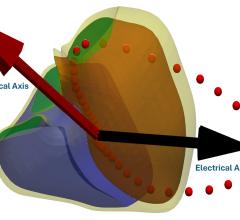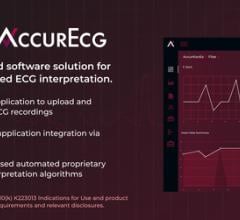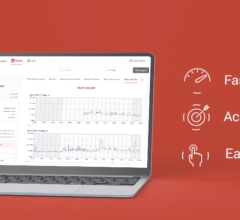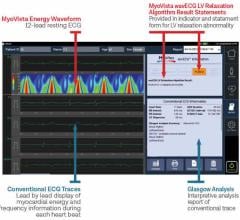Figure 1. ECG (leads II and V5) recorded during the recovery period of the MTWA test. While not visible to the human eye, the Cambridge Heart system was able to detect microvolt-level T-wave alternans prior to the onset of VT/VF.
T-wave alternans (TWA) refers to an alternating pattern in the T-wave of the electrocardiogram (ECG) and is recognized as a marker of electrical instability. Visible or macroscopic alternans was first reported in the context of proarrhythmic conditions including Prinzmetal’s angina and long QT syndrome, and was often found to immediately precede the onset of ventricular tachycardia or fibrillation [1-3]. More recently, techniques have been developed to measure microvolt-level T-wave alternans (MTWA) not visible to the human eye [4]. The presence of MTWA has been linked with increased risk of sudden cardiac arrest (SCA) in several patient populations [5-8]. This study presents the case of a patient who experienced VF during the recovery phase of an MTWA stress test. While there was no visible abnormality on the ECG which would alert to the impending arrhythmia, significant microvolt-level alternans was detected immediately prior to the cardiac arrest.
Case History
A 72-year-old male with coronary artery disease, chest discomfort and bilateral arm discomfort underwent dobutamine stress testing with myocardial perfusion imaging (MPI). The MPI study was abnormal with large fixed defects in the anterior, septal and lateral walls and a left ventricular ejection fraction (LVEF) of 39 percent. Due to the patient’s ischemic cardiomyopathy and moderately reduced LVEF, an MTWA test was ordered to further assess the patient’s risk for ventricular tachyarrhythmias and sudden cardiac arrest.
MTWA Test and VF Arrest
MTWA testing was performed with treadmill exercise using the HearTwave II system from Cambridge Heart. At the time of the test, the patient was in normal sinus rhythm. The heart rate was elevated to the target range of 100-120 bpm by gradually adjusting the workload to a maximum of 3.7 METS. At peak exercise, the patient developed downsloping ST segment depression in the antero-lateral and inferior leads and reported shortness of breath but denied chest pain. Approximately two and half minutes into the recovery phase, the patient developed polymorphic ventricular tachycardia which quickly deteriorated into ventricular fibrillation (VF) (Figure 1). An automatic external defibrillator (AED) was applied within three minutes and the patient was successfully defibrillated on the second attempt.
Upon review of the test, ST segment changes suggestive of ischemia were evident, but there were no urgent symptoms or overt indications on the ECG that signaled the impending arrhythmia (e.g., ventricular ectopy or visible repolarization alternans). From the MTWA report, however, it is clear that non-visible microvolt-level T-wave alternans was present during the exercise portion of the test and immediately preceded the onset of VF (Figure 2).
Follow-Up
Following the cardiac arrest, the patient underwent coronary bypass surgery (x2) for significant disease in the left anterior decending (LAD) and left circumflex coronary arteries which he tolerated well. One month after the bypass surgery, his LVEF was 42 percent by MUGA. During a stress echocardiography assessment 18 months later, the patient showed no symptoms or exercise-induced dysrhythmias and an LVEF of 45 percent.
Discussion
While macroscopic TWA on the surface ECG has been observed as an immediate precursor to ventricular tachyarrhythmias, few cases have reported microvolt-level (but visually inapparent) alternans as a harbinger of imminent VT or VF [9]. In this case, there were no overt signs to herald the onset of ventricular fibrillation; however, upon retrospective review of the report, it is clear that MTWA was present in the minutes preceding the event.
In this case, MTWA was concomitant with ST changes indicative of active ischemia, a common underlying cause of ventricular tachyarrhythmias and sudden cardiac arrest [10]. Ischemia has also been mechanistically linked to repolarization alternans via altered calcium cycling that occurs in cardiac myocytes when perfusion is reduced [11, 12]. MTWA detected during stress testing, particularly in the context of ST changes or symptoms, may indicate the presence of active ischemia that is especially arrhythmogenic and may identify patients in whom coronary angiography should not be delayed. As such, MTWA may be used to enhance the diagnostic yield of traditional stress testing.
For more information: www.cambridgeheart.com
References:
1. Rozanski JJ and Kleinfeld M. "Alternans of the ST segment of T wave. A sign of electrical instability in Prinzmetal's angina." Pacing Clin Electrophysiol 1982; 5(3): 359-65.
2. Schwartz PJ and Malliani A. "Electrical alternation of the T-wave: clinical and experimental evidence of its relationship with the sympathetic nervous system and with the long Q-T syndrome." Am Heart J 1975; 89(1): 45-50.
3. Surawicz B and Fisch C. "Cardiac alternans: diverse mechanisms and clinical manifestations." J Am Coll Cardiol 1992; 20(2): 483-99.
4. Bloomfield DM, Hohnloser SH, and Cohen RJ. "Interpretation and classification of microvolt T wave alternans tests." J Cardiovasc Electrophysiol 2002; 13(5): 502-12.
5. Bloomfield DM, Bigger JT, Steinman RC, et al. "Microvolt T-wave alternans and the risk of death or sustained ventricular arrhythmias in patients with left ventricular dysfunction." J Am Coll Cardiol 2006; 47(2): 456-63.
6. Chow T, Kereiakes DJ, Bartone C, et al. "Prognostic utility of microvolt T-wave alternans in risk stratification of patients with ischemic cardiomyopathy." J Am Coll Cardiol 2006; 47(9): 1820-7.
7. Ikeda T, Yoshino H, Sugi K, et al. "Predictive value of microvolt T-wave alternans for sudden cardiac death in patients with preserved cardiac function after acute myocardial infarction: results of a collaborative cohort study." J Am Coll Cardiol 2006; 48(11): 2268-74.
8. Salerno-Uriarte JA, De Ferrari GM, Klersy C, et al. "Prognostic Value of T-Wave Alternans in Patients With Heart Failure Due to Nonischemic Cardiomyopathy: Results of the ALPHA Study." J Am Coll Cardiol 2007; 50(19): 1896-1904.
9. Sedkowska A, Sredniawa B, Kowalczyk J, Lenarczyk R, Kowalski O, and Kalarus Z. "Immediate ventricular tachycardia after abnormal microvolt T-wave alternans." Cardiol J 2009; 16(4): 365-7.
10. Luqman N, Sung RJ, Wang CL, and Kuo CT. "Myocardial ischemia and ventricular fibrillation: pathophysiology and clinical implications." Int J Cardiol 2007; 119(3): 283-90.
11. Kapur S, Wasserstrom JA, Kelly JE, Kadish AH, and Aistrup GL. "Acidosis and ischemia increase cellular Ca2+ transient alternans and repolarization alternans susceptibility in the intact rat heart." Am J Physiol Heart Circ Physiol 2009; 296(5): H1491-512.
12. Nearing BD and Verrier RL. "Progressive increases in complexity of T-wave oscillations herald ischemia-induced ventricular fibrillation." Circ Res 2002; 91(8): 727-32.

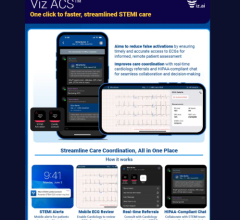
 October 09, 2025
October 09, 2025 



